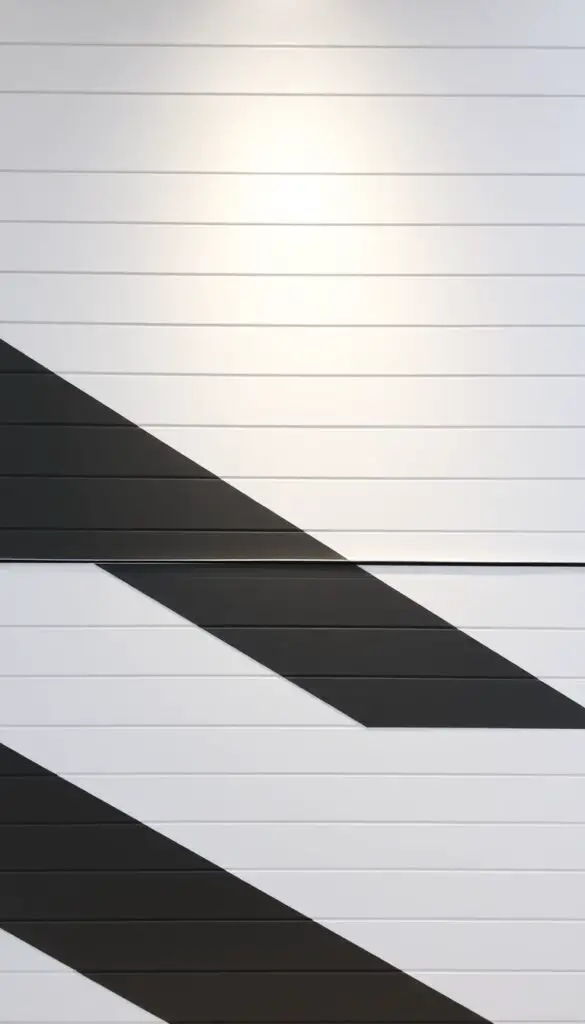Did you know that 75% of real estate agents agree that homes with stylish wallpaper sell faster? This timeless trend is making waves in modern design, offering a perfect blend of elegance and versatility. Whether you’re refreshing a single room or revamping your entire home, this Black and White Wallpaper can transform any space effortlessly.
Black and white patterns are more than just a classic choice. They create a striking visual impact, making your wall the focal point of any room. From geometric prints to soft watercolor designs, these options cater to every taste. Plus, their neutral palette allows you to experiment with bold or subtle accents, giving your space a personalized touch.
Ready to explore how this interior game-changer can elevate your home? Keep reading to discover tips, trends, and inspiration for your next décor project.
Key Takeaways
- Stylish wallpaper can increase your home’s appeal and resale value.
- Black and white designs offer timeless elegance and modern versatility.
- Neutral palettes allow for creative accent pairings.
- Geometric and watercolor patterns are trending in home décor.
- Easy installation makes it a practical choice for any space.
Introducing Chic Black and White Wallpaper to Elevate Your Décor
Transform your space with the timeless elegance of monochrome designs. These patterns bring a sophisticated touch to any room, making them a favorite among homeowners and designers alike. Whether you’re updating a cozy bedroom or adding flair to a living area, this product is a game-changer.
Why choose neutral tones for your walls? They create a versatile base that complements any style. From bold geometric prints to soft, artistic designs, there’s something for every taste. Plus, these patterns can make a small room feel larger or add depth to a spacious area.
One standout feature is the use of murals as a focal point. A striking design can turn a plain wall into a work of art. For example, a graphic mural in a bedroom can set the tone for the entire space, creating a serene or energetic vibe depending on the pattern.
Looking for a quick way to refresh your home? Consider an accent wall. This simple addition can completely transform a room without overwhelming it. Pair it with minimalist furniture or bold accessories for a cohesive look.
Here’s why this product fits seamlessly into any design aesthetic:
- It’s versatile, working well in modern, vintage, or eclectic spaces.
- Neutral tones allow for creative freedom with accents and décor.
- Easy to install and maintain, making it a practical choice.
Ready to elevate your décor? Start with a chic monochrome design and watch your space come to life.
Timeless Appeal and Modern Trends
Combining classic elegance with modern flair, monochrome patterns remain a top choice for interiors. Their enduring charm lies in their ability to adapt to changing trends while maintaining a sophisticated look. Whether you’re designing a cozy bedroom or a chic living room, these designs offer unmatched versatility.
Modern trends often draw inspiration from vintage aesthetics. For example, geometric prints paired with subtle textures can create a contemporary yet timeless feel. Vertical stripes, a classic pattern, can make a room appear taller, adding a sense of spaciousness.
In a home, white accents can refresh any space. A feature wall with a soft watercolor design can brighten a room, while bold graphic patterns add drama. These elements allow you to experiment with different styles without overwhelming the space.
Here’s how monochrome designs blend old and new:
- Pair vintage-inspired patterns with minimalist furniture for a balanced look.
- Use peel-and-stick options for quick updates that reflect modern trends.
- Combine bold geometric prints with soft neutrals for a cohesive aesthetic.
Ready to transform your space? Embrace the timeless appeal of monochrome designs and watch your home come to life.
Product Roundup: A Curated Collection of Designs
Discover a handpicked selection of designs that blend modern trends with timeless elegance. This collection offers something for every taste, from bold geometric patterns to soft vintage motifs. Whether you’re updating a cozy room or adding flair to a living space, these options ensure your wall becomes a statement piece.
Contemporary Graphics and Geometry
Modern interiors thrive on clean lines and striking visuals. Graphic patterns, like geometric shapes and abstract art, bring a fresh, dynamic energy to any space. These designs are perfect for creating a focal point in a minimalist or eclectic room.
For example, vertical or horizontal stripe patterns can enhance the perception of space, making a small area feel larger. Pair these with neutral furniture for a balanced look.
Vintage Inspirations
Vintage-inspired designs bring a touch of nostalgia to your home. Think retro geometrics, Art Deco motifs, or soft watercolor prints. These patterns add character and warmth, making them ideal for cozy bedrooms or classic living rooms.
Quality and durability are key features of these products. Many options are easy to install and maintain, ensuring your wallpaper stays fresh for years.
Here’s why this collection stands out:
- It caters to diverse styles, from modern to vintage.
- High-quality materials ensure long-lasting appeal.
- Versatile designs allow for personalized room transformations.
Ready to elevate your space? Explore this curated selection and find the perfect design to reflect your unique style.
Versatility in Every Room
Monochrome designs bring a fresh, adaptable vibe to any space in your home. Whether it’s a lively living area or a serene bedroom, these patterns effortlessly enhance the atmosphere. Their neutral palette allows for endless creativity, making them a favorite for both modern and traditional interiors.
Stylish Living Rooms
Transform your living room into a chic haven with bold geometric prints. These designs create a striking focal point, perfect for entertaining or relaxing. Pair them with minimalist furniture for a clean, modern look.
For a softer touch, consider floral patterns. They add elegance without overwhelming the space. A monochrome feature wall can tie the room together, creating a cohesive and inviting environment.
Cozy Bedrooms
In the bedroom, balanced contrast creates a calming retreat. Soft watercolor designs or subtle textures can enhance relaxation. These patterns work well with neutral bedding and soft lighting.
For a playful twist, explore kid-friendly options. Fun patterns, like stars or animals, can make a child’s room feel magical. Monochrome designs ensure the space remains stylish and timeless.
From bold statements to subtle accents, monochrome patterns adapt beautifully to every room. Ready to elevate your space? Start with a design that reflects your unique style.
Minimalist Aesthetics for Modern Interiors
Minimalist aesthetics have become a cornerstone of modern interior design. This trend focuses on clean lines, uncluttered spaces, and a neutral palette. It’s a style that brings calm and sophistication to any home.
Subtle textures and monochrome palettes play a key role in enhancing modern spaces. These elements add depth without overwhelming the room. A touch of vintage charm can elevate minimalist spaces, blending old and new seamlessly.
Pared-back aesthetics emphasize quality over quantity. This approach allows each piece in the room to stand out. A feature wall can anchor the space, creating a focal point that draws the eye.
Modern wallpaper options emphasize subtle textures and easy installation. Peel-and-stick varieties are perfect for quick updates. These products are designed to complement minimalist design principles.
The black white palette creates timeless elegance. It’s versatile, allowing for creative freedom with accents and décor. This combination ensures your space remains stylish and serene.
| Feature | Benefit |
|---|---|
| Clean Lines | Creates a modern, uncluttered look |
| Subtle Textures | Adds depth without overwhelming the space |
| Easy Installation | Perfect for quick updates and DIY projects |
| Neutral Palette | Allows for versatile décor pairings |
Ready to embrace minimalist aesthetics? Start with a clean slate and let simplicity transform your space.
Bold and Artistic Pattern Statements
Bold patterns are making waves in modern interiors, offering a fresh take on artistic expression. These designs go beyond traditional décor, turning walls into captivating focal points. Whether you’re updating a cozy room or adding flair to a living room, these patterns bring personality and style.
Artistic Lines and Brushstroke Designs
Hand-painted brushstrokes and abstract lines are redefining wall art. These techniques create a sense of movement and depth, making your wall a true masterpiece. For example, a mural with soft, flowing lines can add elegance to a bedroom, while bold, graphic strokes energize a living space.
Custom murals allow for personalization, ensuring your design reflects your unique taste. With options like peel-and-stick panels, installation is simple and stress-free.
Contrast Art Innovations
Contrast art is another trend making a statement. By pairing light and dark elements, these designs draw attention and create visual interest. A feature wall with a high-contrast mural can transform a plain room into a modern haven.
For example, a black-and-white abstract pattern adds drama to a minimalist space. These designs are versatile, working well in both residential and commercial settings.
Ready to elevate your space? Start with a bold pattern and let your walls tell a story.
Stripes, Florals, and Geometric Inspirations
Stripes, florals, and geometric patterns are timeless choices for elevating your home’s aesthetic. These designs offer versatility, allowing you to create a space that feels both classic and contemporary. Whether you prefer bold statements or subtle accents, these patterns can redefine any room.
Stripes, for example, bring a sense of order and sophistication. Vertical lines can make a room feel taller, while horizontal stripes add width. Pair a stripe pattern with minimalist furniture for a clean, modern look.
Floral designs, on the other hand, add a touch of elegance and warmth. Traditional motifs create a vintage vibe, while modern interpretations offer a fresh take. Use floral patterns in a bedroom or living area to create a cozy, inviting atmosphere.
Geometric patterns are perfect for adding a dynamic edge. From hexagons to trellis designs, these shapes create visual interest and movement. A bold geometric wall can serve as a focal point, especially in a minimalist space.
Here’s how to mix and match these patterns for a cohesive look:
- Combine stripes with florals for a balanced, layered effect.
- Use geometric designs as an accent to complement softer patterns.
- Pair black white patterns with colorful décor for a striking contrast.
Ready to transform your space? Start with a pattern that speaks to your style and let your creativity shine.
Transform Your Space with black and white wallpaper
Revitalize your home with the striking elegance of monochrome designs. A single accent wall can completely redefine your room, turning it into a focal point of style and sophistication. Whether you’re aiming for a modern or classic look, these patterns offer endless possibilities.
Contrasting colors add depth and dimension to any space. A bold geometric design can make a small area feel larger, while soft textures create a calming atmosphere. The simplicity of black white combinations ensures your décor remains timeless and versatile.
Consider a before-and-after project where a plain wall becomes a work of art. For instance, a graphic mural in a living room can set the tone for the entire space. Pair it with minimalist furniture or vibrant accents for a cohesive look.
Ready to transform your home? Start with a chic wallpaper design and watch your space come to life. Let your creativity shine and envision the possibilities of a revamped interior.
Innovative Wall Murals for a Contemporary Look
Urban interiors are redefined with innovative wall murals that blend modern and vintage elements. These designs bring a fresh, artistic vibe to any space, making them a favorite for those seeking a contemporary look. Whether you’re updating a living room or adding flair to a bedroom, murals can transform your walls into stunning focal points.
Urban chic designs often mix bold patterns with subtle textures. For example, a stripe pattern paired with soft brushstrokes creates a dynamic yet balanced aesthetic. These combinations allow you to experiment with contrast while maintaining a cohesive look.
Urban Chic Designs
Urban chic murals often draw inspiration from vintage aesthetics. Think retro geometrics or abstract art with a modern twist. These designs add character and depth, making them ideal for both residential and commercial spaces.
One standout feature is the use of high-contrast elements. A black white mural can create a striking visual impact, turning a plain wall into a work of art. These designs are versatile, working well in minimalist or eclectic interiors.
Here are some tips for incorporating murals into your space:
- Choose a design that complements your existing décor.
- Use murals as an accent wall to avoid overwhelming the room.
- Pair bold patterns with neutral furniture for a balanced look.
Installation is simple, thanks to peel-and-stick options. These murals are easy to apply, reposition, and remove without damaging your wall. This makes them a practical choice for renters or those who love to refresh their space often.
| Feature | Benefit |
|---|---|
| Customizable Designs | Tailor murals to fit your unique style |
| Easy Installation | Peel-and-stick options for hassle-free updates |
| High-Contrast Patterns | Create a striking visual impact |
| Durable Materials | Ensure long-lasting appeal |
Ready to elevate your space? Start with an urban chic mural and watch your room transform into a contemporary masterpiece.
Customized Options to Reflect Your Style
Personalized décor is the key to making your home truly unique. With customizable wallpaper, you can transform any room into a reflection of your personality. From adjusting colors to tweaking patterns, the possibilities are endless.
Why settle for generic designs when you can create something tailored to your taste? A curated collection of customizable options ensures you find the perfect fit for your space. Whether you prefer bold geometrics or soft florals, your wall can become a statement piece.
Here’s how customization works:
- Choose from a wide range of patterns and textures.
- Adjust colors to match your existing décor.
- Add personal touches like monograms or illustrations.
Many homeowners have successfully personalized their spaces. For example, one family transformed their living room with a custom black white mural that captured their love for travel. Another added a playful pattern to their child’s bedroom, creating a magical atmosphere.
Ready to explore your options? Dive into full collections and discover the perfect design for your home. Let your creativity shine and make your space uniquely yours.
| Customization Feature | Benefit |
|---|---|
| Color Adjustments | Match your existing décor seamlessly |
| Pattern Tweaks | Create a design that fits your style |
| Personal Additions | Add unique touches like monograms |
| Eco-Friendly Materials | Ensure a sustainable choice for your home |
Practical Tips for Easy Installation and Maintenance
Upgrade your space effortlessly with these practical tips for installing and maintaining chic designs. Whether you’re a DIY enthusiast or a first-timer, these steps ensure a flawless finish that lasts.
Step-by-Step Installation Guide
Start by preparing your wall. Clean the surface thoroughly to remove dust and grease. For textured walls, consider smoothing them with plaster for better adhesion. Measure the height and width of your wall to calculate the required material.
Pre-cut the strips to match the wall height, adding an extra inch for trimming. Peel the backing slowly, aligning the top edge with a level line. Smooth out air bubbles with a squeegee or soft cloth as you go. Trim excess material at the edges for a clean finish.
For kid-friendly spaces, choose durable, washable options that withstand wear and tear. A stripe pattern can add visual interest while being easy to align during installation.
Maintenance Tips for Longevity
Keep your wallpaper looking fresh with regular care. Use a soft brush or vacuum attachment to remove dust from textured designs. For stains, gently wipe with a damp cloth and mild soap. Avoid harsh chemicals that could damage the material.
If you notice raised edges or blistering, press them down gently with a warm, damp cloth. For repairs, use scraps to patch small tears, ensuring the pattern matches seamlessly. These steps ensure your home remains stylish and well-maintained.
- Clean the wall surface thoroughly before installation.
- Pre-cut strips for easier alignment and application.
- Use a squeegee to smooth out air bubbles during installation.
- Clean with mild soap and water for long-lasting appeal.
- Patch small tears with matching scraps for seamless repairs.
With these tips, your wall will become a stunning focal point in any room. Enjoy the process and watch your space transform into a masterpiece.
Interior Design Insights for a Cohesive Look
Achieving a cohesive interior design starts with balancing key elements like color, texture, and patterns. A well-designed space feels harmonious, where every piece complements the others. Whether you’re working on a bedroom or a living area, these tips will help you create a unified look.
Start with a neutral backdrop. Light walls or subtle textures provide a canvas for bolder accents. For example, a black white palette can anchor the room while allowing colorful décor to shine. This approach ensures your space feels balanced, not overwhelming.
Accent walls are a great way to add depth without dominating the room. A mural can serve as a focal point, tying together different design elements. Place it strategically, such as behind a bed or sofa, to draw the eye and create flow.
Integrating new trends with classic styles is another key to cohesion. Pair modern geometric patterns with vintage furniture for a timeless yet fresh look. This blend keeps your space current without losing its character.
Here are some expert tips for a harmonious atmosphere:
- Use a consistent color palette throughout the room.
- Balance bold patterns with neutral textures.
- Place furniture to encourage conversation and interaction.
- Incorporate plants for a touch of nature and warmth.
For inspiration, consider a bedroom with soft watercolor wallpaper paired with crisp white bedding. Or a living room with a bold geometric accent wall and minimalist furniture. These examples show how careful planning can create a cohesive and inviting space.
Ready to transform your home? Start with these insights and watch your rooms come together beautifully.
Mixing Patterns: Creative Combinations
Mixing patterns can transform your space into a dynamic and personalized haven. It’s an art that allows you to express your unique style while creating a cohesive look. Whether you’re blending bold prints with subtle backdrops or experimenting with contrasting elements, the possibilities are endless.
Balancing Bold and Subtle Designs
Start by choosing a focal point. A bold geometric design can serve as the centerpiece, while softer patterns like florals or textures provide balance. For example, pair a large-scale stripe with a delicate watercolor motif. This contrast adds depth without overwhelming the room.
Lighting plays a crucial role in how patterns interact. Natural light can enhance subtle textures, while artificial light can make bold prints pop. Experiment with different lighting setups to see how your combinations come to life.
Here are some tips for successful pattern mixing:
- Use a consistent color palette to tie different designs together.
- Vary the scale of patterns—pair large prints with smaller ones for visual interest.
- Incorporate solid textures or neutral tones to break up busy patterns.
Real-life examples show how this approach works. One homeowner combined a black white mural with soft floral accents in their living room. The result was a space that felt both modern and inviting.
Don’t be afraid to experiment. Mixing patterns is about finding what resonates with you. Start small, perhaps with an accent wall, and build from there. Your home should reflect your personality and creativity.
Enhancing Kitchen and Communal Spaces
Kitchens and communal spaces are often the heart of the home, and their design deserves special attention. These areas require décor that’s both stylish and practical, blending aesthetics with functionality. One standout option is using wallpaper to add character and depth.
Monochrome designs bring a modern edge to these spaces. A black white palette creates a sleek, timeless look that complements any style. Whether it’s a bold geometric pattern or a subtle texture, these designs can transform a plain wall into a focal point.
Durability is key in high-traffic areas like kitchens. Stain-resistant materials ensure your wallpaper stays fresh, even in busy environments. For added protection, consider using clear acrylic panels in high-use zones, such as behind sinks or stoves.
Murals are another excellent choice for creating visual impact. A striking mural can turn a kitchen island or accent wall into a conversation piece. These designs add personality and make the space feel uniquely yours.
Here are some tips for enhancing your kitchen and communal spaces:
- Choose patterns that complement your cabinetry and overall color scheme.
- Use wallpaper in unconventional spots, like ceilings or behind open shelves.
- Pair bold designs with neutral textures for a balanced look.
- Opt for easy-to-clean materials to maintain long-lasting appeal.
Ready to elevate your kitchen? Start with a chic monochrome design and watch your space come to life. With the right wallpaper, your kitchen can become a stylish and functional hub for your home.
Unveiling the Impact of Color and Contrast
The interplay of light and dark can redefine the mood of any room. Contrasting colors have the power to transform spaces dramatically, creating visual interest and depth. A black white wallpaper design, for example, can make a bold statement while maintaining timeless elegance.
Monochrome palettes are more than just visually striking. They evoke a sense of balance and sophistication, making them a popular choice for modern home interiors. The high contrast between light and dark tones can enhance textures and patterns, adding dimension to your wall.
Studies show that contrasting colors can influence mood and perception. A room with bold contrasts feels dynamic and energetic, while softer contrasts create a calming atmosphere. This versatility allows you to tailor your space to suit your personality and lifestyle.
Here are some tips for integrating dramatic contrasts without overwhelming your space:
- Use a neutral base to balance bold patterns.
- Pair large-scale designs with subtle textures for harmony.
- Experiment with lighting to enhance the visual impact of contrasts.
Ready to transform your home? Start with a black white palette and explore the endless possibilities of color and contrast. Let your creativity shine and watch your space come to life.
Can Cartoon Wallpapers Complement Black and White Décor?
Cartoon wallpapers can add a playful contrast to a black-and-white décor, creating a striking visual appeal. Their vibrant colors bring warmth and personality without overwhelming the monochrome theme. Choosing minimalist or grayscale cartoon designs ensures harmony. Also Read : Cute Cartoon Wallpapers for more inspiration on playful yet elegant interiors.
Conclusion
Elevate your home’s aesthetic with chic monochrome designs that blend timeless elegance and modern versatility. From bold geometric murals to subtle textures, these patterns transform any wall into a statement piece. Whether you’re updating a cozy bedroom or a lively living area, the black white palette ensures your space remains stylish and adaptable.
Our curated design collection offers something for every taste, from kid-friendly patterns to sophisticated motifs. Easy installation and maintenance make it a practical choice for busy households. Plus, the neutral tones allow for endless creativity with accents and décor.
Ready to start your décor makeover? Explore our full range of customizable options and find the perfect fit for your home. Let your creativity shine and transform your space into a reflection of your unique style.
















